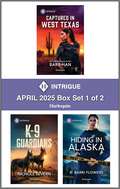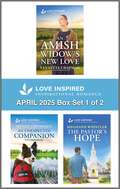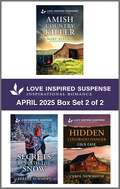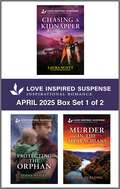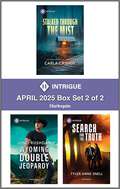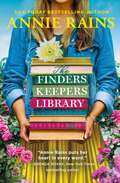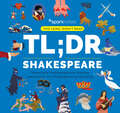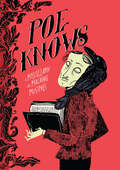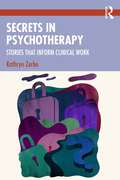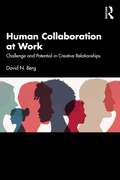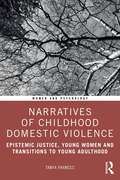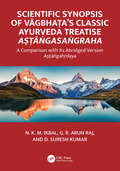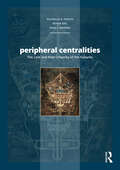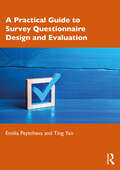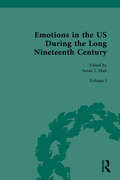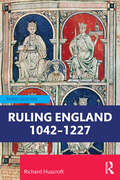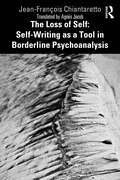- Table View
- List View
Harlequin Presents April 2025 - Box Set 1 of 2
by Heidi Rice Emmy Grayson Michelle Smart Lorraine HallHarlequin Presents brings you four full-length stories in one collection! Experience the glamorous lives of royals and billionaires, where passion knows no bounds. Be swept into a world of luxury, wealth and exotic locations.This box set includes:SPANIARD&’S SHOCK HEIRSby Michelle SmartThe stakes are always high at billionaire hotelier Diaz Martinez&’s exclusive poker game, never more so than when his estranged wife Rose approaches the table. She makes the requisite ten-million-dollar bet, then drops her bombshell: she&’s pregnant…with his heirs!Their electrifying night was the last time Rose saw her husband. Now he&’s insisting they raise their daughters together, she&’s torn… Her children deserve a father, but she risks reawakening feelings she believes Diaz can&’t return. Especially as breathing the same air as him brings their chemistry roaring back to life!THE BRIDE WORE REVENGE (A Work Wives to Billionaires&’ Wives novel)by Lorraine HallAfter an unforgivable betrayal, Greek tycoon Athan Akakios is taking his ruthless father down. Step one: convince chef Lynna Carew to be his bride. And together they can get their revenge – since Lynna is the one person who detests Athan&’s family more than he does…Athan&’s father is the reason her loved ones were left destitute. She walks down the aisle only because Athan is restoring the Carew fortune. Still, she&’s adamant – she&’ll never trust an Akakios. Until her fiery scorn gives way to desire…and it burns hotter than vengeance!PRINCESS FOR THE HEADLINES (A By Royal Arrangement novel)by USA TODAY bestselling author Heidi RiceHer night with playboy Prince Rene of Saltzaland was enough for royal assistant Melody Taylor to know she wouldn&’t survive falling for him. Despite being snowbound together four years later, she&’s powerless against their desire… Yet, after photos of their red-hot reunion become headline news, even Mel couldn&’t have predicted Rene&’s reaction…Honor-bound to shield her, Rene announces their engagement then whisks his &“princess-to-be&” to away. Taught since childhood that love is a lie, he can&’t promise more than his protection. But with Mel, devotion is dangerously easy to fake…STILL THE GREEK&’S WIFE (A Brides for Greek Brothers novel)by Emmy GraysonTessa. My marriage to Greek billionaire Rafael Drakos wasn&’t the whirlwind union I desperately wanted it to be. Discovering that opened my eyes to how sheltered my existence really is. I&’ll no longer deny myself the love and passion I deserve – so I want a divorce…Rafe. My convenient bride can&’t have what she wants…yet. Not until we&’ve been wed a year and I can inherit my birthright. Still, I don&’t expect what innocent Tessa requests in return: a wedding night. Or the wildfire of raw need it unleashes in me!For more stories filled with passion and drama, look for Harlequin Presents April 2025 – Box Set 2 of 2
Harlequin Heartwarming April 2025 Box Set: A Clean and Uplifting Romance
by Susan Breeden Tanya Agler Anna Grace Kristi HongHarlequin® Heartwarming celebrates wholesome, heartfelt relationships that focus on home, family, community and love. Experience all that and more with four new novels in one collection!This Harlequin Heartwarming box set includes:HER SECRET HOMECOMINGThe Teacher Projectby Anna GraceIs her secret past…The key to their future?Luci Walker has come a long way from her sheltered upbringing. Now she&’s back in Pronghorn, Oregon, helping to revive the local school and inspire kids like her who want to see the world. Yet she&’s kept her past a secret from her fellow teachers—especially the frustratingly easygoing Mateo Lander. But when Mateo and Luci must work together to turn the old hotel into a student dormitory, Luci&’s past becomes very present, and she faces a tough lesson of her own: how to accept her history—and the love of her best friend. THE TEACHER&’S MATCHby Kristi HongA new career. A new school.And a very inconvenient new crushJoanna Lin is determined to avoid her mother&’s matchmaking. With a new career as an art teacher at a Mandarin immersion school, Joanna refuses to let anything or anyone distract her. Especially her charming new colleague Jack Sun. His kindness and passion for teaching—not to mention those dimples!—are practically irresistible. But anything beyond friendship is impossible, especially when Jack&’s moving to Taiwan at the end of the school year. But as spring—and the school&’s Dragon Boat Festival—draws closer, love might send all of their careful plans tumbling overboard.SAVING THE RANCHERA Violet Ridge Novelby Tanya AglerWill she save his ranch…And steal his heart?How dare Amanda Fleming score a free vacation from his trusting grandparents under the guise of rebranding their Lazy River Dude Ranch? Or so manager Seth Virtue thinks at first. When a family secret reveals just how much the ranch needs Amanda&’s expertise, she becomes a lifeline. And Amanda herself is a breath of fresh air around Seth&’s beloved ranch. But the Phoenix-based marketing maven has no plans to stay in small-town Violet Ridge, the only home Seth can imagine. Which makes mixing business and getting to know Amanda better a tricky idea… AND COWBOY MAKES THREEDestiny Springs, Wyomingby Susan BreedenMending fences…And healing heartsA normal childhood—that&’s all single mom Vanessa Fraser wants for her son, PJ. And starting her own home care business will help her achieve that goal…unless she gets sidetracked by a handsome cowboy. Austin Cassidy needs a caregiver to help his grandmother recover from hip surgery, so Vanessa agrees to step in—temporarily. Austin and PJ soon develop a sweet connection. And Vanessa is falling for the protective cowboy. But they&’re both leaving Destiny Springs, heading in different directions. Unless love puts them on a new path…Look for 4 compelling new stories every month from Harlequin® Heartwarming!
Harlequin Romantic Suspense April 2025 - Box Set
by Addison Fox Kacy Cross Linda O. Johnston Sandra OwensLooking for heart-racing romance and breathless suspense? Want stories filled with life-and-death situations that cause sparks to fly between adventurous, strong women and brave, powerful men?COLTON AT RISKby Kacy CrossAt the ultra-luxurious Mariposa Resort, activities director Joshua Colton enforces a strict no- fraternization policy among staff. He loves his work, the land&’s Western vibe and Mariposa&’s legacy. A relationship has no place in his life—he doesn&’t do serious. Neither does sexy new bartender Kelli Iona. Independence is her mantra, and working for Josh—her boss—is not going to derail her dreams. But an irresistible attraction threatens their professional connection. And when Kelli&’s life is endangered, Josh will do anything to protect her…even if it means breaking all the rules. RENEGADE REUNIONby Addision FoxFormer CIA operative Trace Withrow traded a high-risk career in DC for a ranch in Wyoming, leaving behind the partner he couldn&’t forget. But when Nicola Miles discovers an inside hit on a missing teen, she turns to Trace, stirring up emotions he&’d buried for years. Nicola never liked his &“toss the rule book&” attitude. In fact, their differences ultimately ended their affair. Yet that very character trait could be the lifeline Nicola needs—especially since she doesn&’t know who she can trust at her own agency. Or if she&’s the ultimate target…or Trace…DANGEROUS SECRETby Sandra OwensHarlow Pressley&’s powerful ex-husband is using his custody of their son to intimidate her. Desperate, she enlists Grayson Montana and his security team to help her reclaim her child. Though her ex has eroded Harlow&’s ability to trust, she instinctively believes in Grayson. But Grayson must suppress his powerful attraction to the determined beauty to help her. Harlow knows the threats to kill anyone she&’s involved with aren&’t empty. And that the secret she&’s keeping about him could put them all in even more danger.CANINE REFUGEby Linda O. JohnstonWhen vet tech and aspiring novelist Janna Welles recognizes Nolan Hoffsler, she needs to know why a bestselling crime writer is hiding out at Chance Animal Shelter. His resolve to hide his true identity weakens as they discuss her manuscript and share a few irresistible kisses. Still, she knows he doesn&’t totally trust her… Until he reveals that the latest threat against his life pits his survival against the lives of people he loves. It&’s up to Janna—and her Australian shepherd mix, Wizzy—to stop Nolan from sacrificing himself to protect others.Harlequin® Romantic Suspense brings you all that and more with four new full-length titles in one collection!
Harlequin Intrigue April 2025 - Box Set 1 of 2
by Barb Han R. Barri Flowers Nichole SevernHarlequin Intrigue brings you three full-length stories in one collection! Dive into action-packed stories that will keep you on the edge of your seat. Solve the crime and deliver justice at all costs.CAPTURED IN WEST TEXASby Barb HanAbi Remington is closing in on the serial killer leaving a trail of dead bodies across the Texas border. But when he eludes justice once again, the US marshal joins forces with FBI Special Agent Grayson Chisolm. Keeping things strictly professional is a challenge when Abi starts developing powerful feelings for the single father. As the perp ramps up his attacks, leaving his chilling signature at each site, Abi and Grayson race to stop him before the trail goes cold—or the next life he takes might be Abi&’s…K-9 GUARDIANSby Nichole SevernWhen King Elsher&’s murdered partner falls in Scarlett Beam&’s path—literally—the DEA Agent and Security Expert find themselves in a deadly cartel&’s crosshairs. The message is clear: stop interfering with their business or they&’ll be the next victims. The past taught King to keep professional and personal separate. But Scarlett&’s wit and determination tempt him to break his code. And then his son his kidnapped, raising the stakes even further. One wrong step can get them killed. Can King get justice…and keep them all alive?HIDING IN ALASKAby R. Barri FlowersA string of mysterious deaths have led ABI Major Crimes investigator Quincy Lankard straight to Giselle Kinard&’s door. She&’s not a suspect, despite her connection to the deceased. But Quincy knows she&’s keeping secrets—big ones threatening people&’s lives. The danger doesn&’t deter his attraction to her, even as he vows to uncover her past. But when he learns she&’s on the run from her abusive ex-fiancé—and Giselle is now the target—he&’ll challenge the sinister predator determined to make her pay…Seek thrills. Solve crimes. Justice served. For more edge-of-your seat romantic suspense, look for Harlequin Intrigue April – Box Set 2 of 2!
Love Inspired April 2025 Box Set - 1 of 2
by Meghann Whistler Mindy Obenhaus Vannetta ChapmanLove Inspired brings you three new titles! Enjoy these uplifting contemporary romances of faith, forgiveness and hope. This box set includes:AN AMISH WIDOW&’S NEW LOVE (An Indiana Amish Market novel)by USA TODAY bestselling author Vannetta ChapmanWhen newly widowed Hope Lambright moves to Indiana with her three sons, the last thing on her mind is romance. And much like his new neighbor, widower Amos Yoder thought love was part of his past. But when Hope boldly asks Amos for a job at his Amish outdoor market, he finds he can&’t say no, and soon their professional relationship blossoms into something more. They&’ve both loved and lost once. Will they be brave enough to risk their hearts for a second time? AN UNEXPECTED COMPANION (A K-9 Companions novel) by Mindy ObenhausAfter losing his family and his leg in a car crash, widower Dirk Matthews dedicates his solitary life to woodworking and his mobility service dog, Molly. That is, until a troubled kid steals from his truck. Desperate to reach her grieving oldest son, widow Tessa Wagner agrees to have the boy help Dirk work on her family&’s ranch. Only she doesn&’t expect her own connection with the carpenter. Soon they&’re feeling more than the shared loss of loved ones. But will past heartbreak stand in the way of their future? THE PASTOR&’S HOPEby Meghann WhistlerWhen pastor Nate Anderson says yes to being his father&’s best man, he certainly doesn&’t expect to be matched up with the maid of honor. The widowed single dad has been alone a long time but has never wanted to give his heart to anyone. Thankfully, recent widow Amanda Kobayashi feels the same way. But when Nate and Amanda are forced to take dance lessons before the wedding, there&’s an undeniable connection between them. Can they ever overcome their losses and give love a second chance? For more stories filled with love and faith, look for Love Inspired April 2025 Box Set – 2 of 2
Harlequin Fortunes of Texas Spring 2025 - Box Set 1 of 1
by Michelle Major Jennifer Wilck Stella BagwellComing soon! Harlequin Fortunes of Texas Spring 2025 - Box Set 1 of 1 by Michelle Major\Stella Bagwell\Jennifer Wilck will be available Apr 01, 2025.
Love Inspired Suspense April 2025 - Box Set 2 of 2
by Mary Alford Teresa Summers Carol NewhouseLove Inspired Suspense brings you three new titles! Enjoy these suspenseful romances of danger and faith.This box set includes: AMISH COUNTRY KILLERby USA Today bestselling author Mary AlfordReopening the investigation of her mother's disappearance puts chief of police Diana Fisher in someone&’s lethal sights. As she delves deeper into the mystery, a murderer resurfaces, targeting the Amish community. Detective Micah Nissley, whose fiancée went missing a decade ago, joins forces with Diana to stop the threats and bring the killer to justice. But can they uncover the connection between Diana and the culprit before she becomes the next victim?SECRETS BENEATH THE SNOWby Teresa SummersSuspicious of his friend&’s fatal accident, ski patroller Graham McAllister is determined to unearth the truth when his friend&’s long-missing sister suddenly appears…with gunmen in pursuit. Now it&’s up to Graham and his K-9, Emmy, to keep Layla Quin safe as they survive the brutal mountain elements and outrun the criminals trying to silence them. Because Layla has a secret that could expose a shocking link to her brother&’s death, and revealing it may come with a deadly price…HIDDEN COLORADO DANGERby Carol NewhouseChasing a burglary suspect, Sheriff Ruby Prescott stumbles upon a chilling discovery in an abandoned theater—a hidden skeleton. She teams up with big-city crime analyst Jeremy Lawson, and they dive into a decades-old cold case. But their investigation soon puts them in the crosshairs of a deadly adversary who will stop at nothing to keep the truth hidden. With their lives on the line, can Ruby and Jeremy solve the mystery before it's too late?For more stories filled with danger and romance, look for Love Inspired Suspense April 2025 Box Set – 1 of 2
Love Inspired Suspense April 2025 - Box Set 1 of 2
by Laura Scott Susan Furlong Jodie BaileyLove Inspired Suspense brings you three new titles! Enjoy these suspenseful romances of danger and faith.This box set includes: CHASING A KIDNAPPER (A Dakota K-9 Unit novel)by USA Today bestselling author Laura ScottWhen patrol officer Trisha McCord's six-month-old son is nearly abducted, K-9 officer West Cole saves him just in time. The single mom has no leads on who would try to take her baby—or why. And West won&’t let her deal with the threat on her own, especially with the kidnapper closing in and attacks escalating. With her child&’s life at stake, Trisha, West and his K-9, Peanut, must race to catch a ruthless criminal in time to save innocent lives—including their own.PROTECTING THE ORPHAN (A Trinity Investigative Team novel)by USA Today bestselling author Jodie BaileyRetired soldier Heath Adler never thought he&’d see his ex-girlfriend, private investigator Rebecca Campbell, again—much less become her protector. But when her stepsister is murdered and her infant nephew is at risk, Rebecca soon has a target on her back. Whoever killed her stepsister is still out there—and they&’re coming for Rebecca and the baby next. Now Heath will do anything he can to guard them both, but it&’s one thing to hunt a killer…and quite another to stop one.MURDER IN THE APPALACHIANSby Susan FurlongAfter unearthing secrets from her late brother&’s police notebook, journalist Emma Hayes discovers his death was no accident—he was murdered. Only someone doesn&’t want Emma to find out the connection to the cold case her brother was investigating…and they&’ll kill to keep it that way. Now Emma must rely on local ER doctor Logan Greer to help her stay alive and follow a trail of elusive evidence. But as they unravel a conspiracy, they realize that the killer could be anyone hiding in the mountains…For more stories filled with danger and romance, look for Love Inspired Suspense April 2025 Box Set – 2 of 2
Harlequin Montana Mavericks Spring 2025 - Box Set 1 of 1
by Melissa Senate Catherine Mann Elizabeth HribComing soon! Harlequin Montana Mavericks Spring 2025 - Box Set 1 of 1 by Melissa Senate\Catherine Mann\Elizabeth Hrib will be available Apr 01, 2025.
Harlequin Intrigue April 2025 - Box Set 2 of 2
by Tyler Anne Snell Juno Rushdan Carla CassidyHarlequin Intrigue brings you three full-length stories in one collection! Dive into action-packed stories that will keep you on the edge of your seat. Solve the crime and deliver justice at all costs.STALKED THROUGH THE MISTby Carla CassidyThe disappearance of five people in Angel Marchant&’s marshland town has left everyone terrified they&’ll be next. And when a voodoo doll with a knife through its heart is left hanging on her front door, Angel turns to the only person she can trust. Ever since she rescued him from the swamp, injured New Orleans photographer Nathan Merrick has been falling hard for Angel. But now the beautiful fisherwoman is the target of a predator whose vendetta of violence will end only when Angel belongs to him forever…WYOMING DOUBLE JEOPARDYby Juno RushdanWaylon Wright can almost accept that he and Melanie Merritt can&’t be together. Dating a detective wouldn&’t just destroy her hopes for career advancement; it might be the end of her job as an assistant district attorney. Then a brutal attack sends his cowboy instincts into overdrive. Finding her assailant may not be his case, but he won&’t let her out of his sight. As the tough prosecutor lets down her guard just enough to get close to Waylon, the killer who wants her dead inches ever closer…SEARCH FOR THE TRUTHby Tyler Anne SnellMissy Clearwater&’s death was ruled a suicide. But Sheriff Liam Weaver believes it was murder. When he helps Blake Bennet following trouble with some locals, she decides to help him. A former sheriff, Blake&’s been keeping a low profile since returning to her hometown to care for her late sister&’s children. Working together to solve the mystery, they&’re powerfully drawn to each other. But when Blake is targeted with violence, they realize there&’s more to this mystery than they thought. And Blake&’s sister&’s death may not have been accidental.Seek thrills. Solve crimes. Justice served. For more edge-of-your seat romantic suspense, look for Harlequin Intrigue April – Box Set 1 of 2!
The Finders Keepers Library (Love in Bloom #1)
by Annie RainsThis heart-warming second chance love story about hope and healing from a USA Today bestselling author is perfect for fans of Raeanne Thayne and Jenny Hale! For a gardener blessed with a green thumb, Savannah Collins&’s life sure seems like it&’s all thorns and zero roses. She has no job, no relationship, and no place to live. With nothing but a car full of plants and her new rescue kitten, Savannah heads to Bloom, North Carolina, to spend the summer with her beloved Aunt Eleanor, a retired librarian. Her aunt shares her love of literature with the Finders Keepers Library, located in her beautiful garden, where anyone can stop by to take or leave a book. When a sudden summer storm destroys the library and many of the roses, it will take a village to get everything ready for the garden wedding taking place in just three weeks. As the entire town joins in to make the necessary repairs, Savannah bonds with their neighbor Evan Sanders over the books that Eleanor has specially handpicked for each of them. Savannah only intends to stay through the summer, but when an unexpected job offer, a sudden health crisis, and a wayward pre-teen push her future in new directions, she has to wonder whether this is the place that she is meant to be—and the family she&’s meant to be with.
TL;DR Shakespeare: Dynamically illustrated plot and character summaries for 12 of Shakespeare's greatest plays (Too Long; Didn't Read)
by SparkNotesThis refresher reference volume features concise character and plot summaries for 12 of Shakespeare&’s best-known plays, drawn from the SparkNotes website and illustrated with colorful infographics. Each of the 12 chapters in this volume runs 6 to 8 pages of text taken from the SparkNotes website, and is illustrated with colorful infographics for easy consumption. The 12 plays featured—six comedies and six tragedies—are among the most famous and most taught of Shakespeare&’s dramas, including Hamlet, King Lear, Macbeth, Romeo and Juliet, The Taming of the Shrew, The Merchant of Venice, Othello, and Julius Caesar.
Stay Dead
by April HenryNew York Times bestselling author April Henry delivers a thrilling murder mystery featuring a teen with an assassin on her trail fighting to uncover the truth behind a government cover up, perfect for fans of Karen McManus."A page-turning cat-and-mouse survival story." —Kirkus ReviewsSometimes, the only way to live is to make sure the world thinks you&’re dead . . . In the aftermath of a car accident that claimed the life of her senator father, sixteen-year-old Milan finds herself adrift, expelled from her third boarding school. Milan&’s mother, who has assumed the senate seat, diverts her private plane to pick up her daughter. But on their way home, a bomb rips off a wing and the plane crashes in the mountains. In her final moments, Milan&’s mother entrusts her with a key. She reveals it will unlock the evidence that so many people have already died for—including Milan&’s father. The only way Milan can survive, her mom tells her, is to let everyone believe she died with the other passengers. Milan is forced to navigate a perilous descent in freezing conditions while outwitting everything from a drone to wild animals. With relentless assassins on her trail, she must untangle the web of deceit and save herself and countless others. Will she piece together the truth in time?"Milan is in a race against time and terror to get to her parents&’ one trusted friend before she ends up dead, too… readers will be intrigued and thrilled to see how it all turns out." —Booklist"The cat-and-mouse between Milan and Lenny adds a thick layer of tension, especially as Lenny closes in on her target… things come together nicely as the climax looms. Perfect for fans of Mindy McGinnis." —School Library Journal
American Sirens: The Incredible Story of the Black Men Who Became America's First Paramedics
by Kevin HazzardThe extraordinary story of an unjustly forgotten group of Black men in Pittsburgh who became the first paramedics in America, saving lives and changing the course of emergency medicine around the world Until the 1970s, if you suffered a medical crisis, your chances of survival were minimal. A 9-1-1 call might bring police or even the local funeral home. But that all changed with Freedom House EMS in Pittsburgh, a group of Black men who became America&’s first paramedics and set the gold standard for emergency medicine around the world, only to have their story and their legacy erased—until now.In American Sirens, acclaimed journalist and paramedic Kevin Hazzard tells the dramatic story of how a group of young, undereducated Black men forged a new frontier of healthcare. He follows a rich cast of characters that includes John Moon, an orphan who found his calling as a paramedic; Peter Safar, the Nobel Prize-nominated physician who invented CPR and realized his vision for a trained ambulance service; and Nancy Caroline, the idealistic young doctor who turned a scrappy team into an international leader. At every turn, Freedom House battled racism—from the community, the police, and the government. Their job was grueling, the rules made up as they went along, their mandate nearly impossible—and yet despite the long odds and fierce opposition, they succeeded spectacularly. Never-before revealed in full, this is a rich and troubling hidden history of the Black origins of America&’s paramedics, a special band of dedicated essential workers, who stand ready to serve day and night on the line between life and death for every one of us.
Poe Knows: A Miscellany of Macabre Musings (Literary Wit and Wisdom)
by Edgar Allan PoeAn illustrated wit-and-wisdom-style packaging of quotes and excerpts from the fiction and nonfiction of Edgar Allan Poe, organized by theme and presented in a lighter-than-Poe context. This book will collect several hundred quotes and aphorisms from Poe&’s poetry, fiction, and nonfiction. Quotes will be organized in thematic chapter groupings, and each chapter will be prefaced with several introductory paragraphs that discuss Poe&’s preoccupation with their subject matter in a lighter vein. Chapter subjects will include such themes as &“Madness,&” &“Dreams,&” &“Revenge,&” &“Mortality,&” and &“Premature Burial.&” Spot illustrations will be distributed through the text.
Secrets in Psychotherapy: Stories that Inform Clinical Work
by Kathryn ZerbeThis book brings together contemporary perspectives from psychodynamic treatment, advances in cognitive science, medicine, and neuroscience in a user-friendly format guiding practitioners from beginner to more advanced practitioner in working with secrets that emerge during psychotherapy.Despite their ubiquity in life and in clinical practice, secrets and secret-keeping receive limited attention in the training and skill set required for mental health clinicians. Drawing on personal experience and clinical expertise as well as film, memoir, and literature, Dr. Kathryn Zerbe shares how secrets come to light in both life and treatment, demonstrating the powerful hold that secrets can have on our lives. This book offers a fresh take on how we view our secrets, and how we can use them as a tool to sustain our most intimate and valued connections over the course of a lifetime. Using cutting-edge research as well as honed clinical expertise, the author suggests how one might go about managing the secrets of everyday living that we must keep as well as how we can identify which we can let go. Particular attention is paid to the mind/body relationship and somatic countertransference reactions. Each chapter suggests guidelines to promote wellness and resilience in the secret keeper, whether that be the psychotherapist or their patient.Written with compassion and in a user-friendly style, Secrets in Psychotherapy will benefit anyone who is navigating the thorny terrain of keeping a secret for themselves or someone they know. It is an essential read for psychotherapists, psychoanalysts, and practicing mental health professionals of all disciplines.
Handbook of Starch Science and Technology
by Long Chen Ming Miao James N. BeMillerFifteen years have passed since the last major treatise on starch was published. Since then, knowledge of the molecular and macromolecular structures of starch; exploration of new sources of commercial starch; modification of the properties of starches via chemical, enzymic, genetic, and physical means; and investigations into potential uses of new products have proliferated. The Handbook of Starch Science and Technology explores new developments in starch science and technologies to achieve new paradigms in the development of natural glucose polymers. New developments of starches with enhanced nutritional and health benefits and specialized starch derivatives are discussed in terms of novel applications for the design of functional products and recent developments for structuring starch that have not been covered in the previous literature. Further, it discusses the uses of starch in the manufacture of starch inclusion complexes and nanoparticles and as a key component in carrier delivery applications.Features: Explores the genetics and physiology of starch biosynthesis Covers the source, isolation, structure, and properties of starches Identifies the structure and behavior of typical components in starch – amylose, amylopectin, and phytoglycogen Includes specific information on the modification and application of starch derivatives Presents current and emerging trends for starch science and technology This timely guide is for scientists and technologists working in the fields of agriculture, biotechnology, food, pharmaceuticals, chemical engineering, nutrition, and human health.
Human Collaboration at Work: Challenge and Potential in Creative Relationships
by David N. BergHuman Collaboration at Work delves into the dynamics of collaboration between two individuals, examining both the challenges and potential in creative relationships and offering a useful resource for all those working with others. The two-person relationship is one of the key building blocks in our understanding of relationships in organizations yet is largely understudied in the literature.This book brings the dyadic relationship to the fore and offers support for those engaging in collaborative relationships in the workplace and beyond. The author reframes challenges as opportunities for partners to leverage their differences and overcome potential conflicts. Through this lens, he provides a nuanced understanding of the interpersonal and contextual factors that influence collaboration.Supported by compelling real-life examples, including the author’s own long-term working relationship with a colleague, this book is an essential guide for those in leadership roles, managers, consultants, and academics alike – anyone seeking to enhance their collaborative relationships in professional settings.
Narratives of Childhood Domestic Violence: Epistemic Justice, Young Women and Transitions to Young Adulthood (Women and Psychology)
by Tanya FrancesNarratives of Childhood Domestic Violence explores young women’s accounts of transitions to young adulthood after domestic violence in childhood, from a psychological perspective.This book centres a dialogue about epistemic justice and how experiences of violence that are marginal, marginalised, and less easily understood through dominant discourses can be listened to and heard. Taking a critical feminist psychological approach, Frances examines gendered and socio-culturally located narrative practices, arguing that narratives about change and transition in young adulthood after childhood domestic violence both re-inscribe societal narratives that can be constraining and present stories of resistance and hope. This book draws attention to the difficulties of being heard and understood when articulating an experience that sits in tension with normative expectations and trajectories for families and children growing up within them. It also examines how tensions in storytelling practices are articulated in creative, nuanced and diverse ways. Frances ends the book by offering considerations for theory, research and practice, including practical implications and interventions and recommendations for policy.This is an essential resource for academics and students interested in violence against women, feminist psychology, childhood abuse and concerns around epistemic justice, as well as professionals in counselling, social work, charity work, law and policy making.
Scientific Synopsis of Vāgbhaṭa’s Classic Ayurveda Treatise Aṣṭāṅgasaṅgraha: A Comparison with its Abridged Version Aṣṭāṅgahṛdaya
by N. K. Ikbal G. R. Raj D. Suresh KumarAyurveda, “the sacred knowledge of longevity”, is India’s gift to the world. It is a holistic medical system and a healthcare framework based on the observation of the human body in health and disease. Ayurveda is considered a secondary of Atharvavēda and is inextricably associated with Hindu culture. Unlocking the treasures of India's time-honored medical heritage, Scientific Synopsis of Vāgbhaṭa’s Classic Ayurveda Treatise Aṣṭāṅgasaṅgraha: A Comparison with its Abridged Version Aṣṭāṅgahṛdaya delves into the heart of Ayurveda, where it emerges from an intricate interplay of natural observations and profound yogic introspection, that shaped its foundational principles over centuries. A pivotal work in this realm, the seventh-century Sanskrit masterpiece Aṣṭāṅgasaṅgraha, weaves together the wisdom of various medical and surgical schools. Drawing inspiration from this, this book sets forth a scientific synthesis, comparing the information contained of this Ayurvedic classic with its more concise rendition, Aṣṭāṅgahṛdaya. Through twelve chapters and over 100 tables, this narrative offers a panoramic view of the celebrated medical text while accentuating its distinctiveness in comparison to its abridged counterpart.Features· Glossary of Sanskrit technical terms.· Describes Latin binomials of all animals, birds and herbs contained within the text.· Explains how the tridōṣa concept manages dynamic systems.Ayurveda is experiencing an increase in popularity worldwide, following the Alma Ata Declaration adopted by the World Health Organization in 1978. Many phytotherapy schools in Europe and the Americas teach Ayurveda as a wellness system. Synopsis of Vāgbhaṭa’s Classic Ayurveda Treatise Aṣṭāṅgasaṅgraha: A Comparison with its Abridged Version Aṣṭāṅgahṛdaya is presented before the world of medicine to explain the tenets of Ayurveda for the benefit of all.
Peripheral Centralities: The Lost and Past Urbanity of the Suburbs (Planning, History and Environment Series)
by Paul J. Maginn Roger Keil Nicholas A. PhelpsThe term ‘peripheral centralities’ may seem something of an oxymoron and yet the spatial peripheries of cities have often been more central to urban development processes than is appreciated. To better understand the nature of peripheral centrality, Peripheral Centralities: The Lost and Past Urbanity of the Suburbs brings together a wide variety of examples of lost and forgotten peripheral centralities of different sizes, purpose, geographical location, and political complexion, dating from the first decades of the twentieth century to the present day. Following the introduction, two chapters provide broad overviews of peripheral centralities in international and national systems of centralities. The next four chapters look at plans from settings as different as Dublin and Shanghai that, for one reason or another, failed to materialize. The following eight chapters each describes cases where projects have been realized, ranging from peripheral townships in England to a Chinese steel city. To conclude the book, the editors highlight the themes revealed in the foregoing chapters and consider the part an appreciation of peripheral centralities might play in the development of urban theory from the outside in.
A Practical Guide to Survey Questionnaire Design and Evaluation
by Emilia Peytcheva Ting YanA Practical Guide to Survey Questionnaire Design and Evaluation summarizes principles, guidelines, and best practices for developing and testing survey questionnaires driven and supported by theoretical and empirical research. It provides a broad overview of literature on questionnaire design, drawing on both theoretical and empirical research.This book consists of three parts. The first covers the survey response process model, which will serve as the theoretical framework to establish the basic principles of writing different types of survey questions (attitudinal, behavioral, demographic, and knowledge). The second part of this book focuses on special topics such as sensitive questions, developing questionnaires for older adults and children, designing a paper survey, designing a web survey and optimizing for a mobile device, developing questionnaires for a multimode survey, and conducting surveys in multiple languages and cultures. The third part of this book describes methods for testing and evaluating survey questions. Topics cover focus groups, cognitive interviewing, expert review, Questionnaire Appraisal System, behavior coding, respondent and interviewer debriefing, randomized experiments, and pilot studies. Given extensive web survey coverage, we also discuss usability testing of web surveys. Finally, we present a brief overview of the use of artificial intelligence and machine learning for questionnaire development and evaluation. Suggestions for further reading, case studies, and discussion questions are included in all chapters.This book will be of interest to those using survey methodology/questionnaires and graduate courses incorporating survey design across the social and behavioral sciences, including psychology, communication studies, nursing and healthcare research, sociology, anthropology, and education.
Emotions in the US During the Long Nineteenth Century: Volume I: 1800–1865
by Susan J. MattThis collection of primary sources examines the history of emotions in the United States, spanning the years 1800-1865. This period was filled with dramatic political, social and economic changes, including the development of a new national identity, the spread of chattel slavery, the rise of capitalism, the surge of religious revivalism, military and settler expansion into Native American, Mexican, and British lands, and the Civil War. While these events have been well studied, this collection explores these upheavals using the lens of the history of emotions. The volumes bring together a rich group of primary sources demonstrating how Americans responded to these large public events. It also includes sources that trace the more private and subjective experiences of daily life during the 19th century, for the era was witness to significant transformations in ideals of family and romantic love, conceptions of honour and courage, anger and indignation, selfishness and greed. It also was a period when new emotions like homesickness and boredom appeared. This fascinating collection of materials, alongside extensive editorial commentary, will be of great interest to students of American History and the History of Emotions.
Ruling England 1042–1227
by Richard HuscroftSince its first publication in 2005, Ruling England has established itself as an authoritative account of English politics and the growth of royal power from 1042.Using chronicle and administrative records, it focuses on the aims and priorities of the kings of England and on how and why the systems which established and enhanced their authority developed during this period. It explores how the machinery of government worked and grew, and how the legal system evolved to consolidate royal control over the kingdom. It also explores the contribution of the English Church to politics and how the partnership between king and clergy was crucial to the consolidation of royal power.Now in its third edition, Ruling England is a key text for students wishing to understand the complexities of medieval kingship in England from 1042 to 1227. It has been expanded chronologically to cover the minority of King Henry III and there are more extensive treatments of the interactions between the rulers of England and their British neighbours, the role of women in English politics during this period and of the place in society occupied by England’s Jewish communities.
The Loss of Self: Self-Writing as a Tool in Borderline Psychoanalysis
by Jean-François ChiantarettoThe Loss of Self considers distinctions and connections between the writing of survival and survival as a mode of being and thinking encountered in analytic work with borderline patients.Jean‑Francois Chiantaretto draws a parallel between Freud’s use of writing in constructing the psychoanalytic edifice and the way each analyst may turn to writing when reflecting on a patient’s analysis. With close reference to the writings of Imre Kertész, the book brings a unique perspective to the literary and historical concept of survival.The Loss of Self will be of interest to psychoanalysts in practice and in training.



